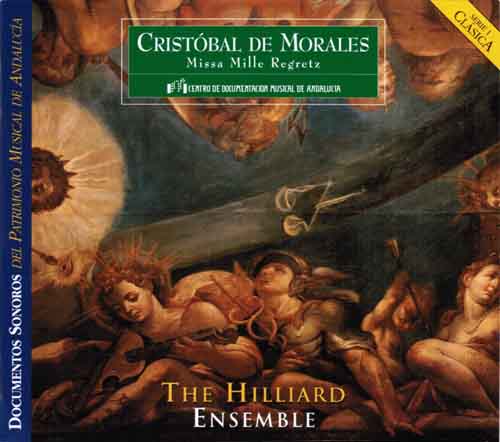Missa Mille Regretz
Detail DS - 0101 You can buy this record here 11 € Missa Mille Regretz Cristobal de Morales
Missa Mille Regretz 1. Kyrie 4'53" 2. Gloria 4'08" 3. Credo 9'07" 4. Sanctus 6'00" 5. Agnus Dei I 2'26" 6. Agnus Dei II 1'45" 7. Agnus Dei III 2'14" 8. MAGNIFICAT 8'44" 9. "LAMENTATOR JACOB" 9'47" 10. "EMENDEMUS IN MELIUS" 4'52" 11. "O CRUX AVE" 2'56" de MISSA "MILLE REGRETZ" 12. Sanctus B 8'14" 13. Agnus Dei I B 2'16" 14. Agnus Dei II B (=II) 1'45" 15. Agnus Dei III B 2'06" 16. "MILLE REGRETZ" (Josquin Després) 2'01" Duración TOTAL: 74'13" |
About The "Mille Regretz" Mass by Morales
There are three printed sources of this Mass. The oldest is dated 1544 and comes from Rome; the second, printed in 1545, from Lyon and finally, that of 1568 is from Wittenberg. There is also a manuscript of the work in the Sistine Chapel in Rome which appears to coincide with the Wittenberg edition. Here, the "Mille Regretz" mass is attributed to the composer Thomas Crecquillon. In Spain there are five ancient copies of this Mass. They can be found in Barcelona (Cataluña and Orfeón Catalán Libraries), Madrid (Medinaceli Library), El Escorial Monastery and Toledo Cathedral. Latter-day editions include that of Martyn Imrie (1983) which pertains to the Mapa Mundi collection. The Mille Regretz mass is composed around the melody of the song of the same name arranged for four voices by Josquin Després. For this reason the mass could becalled parodical in musicological terms. Luis de Narváez used the song in bis Los Seis Libros del Delphin de Música (1538) where it is played on the 'vihuela’. The Granada-born composer called the "Mille Regretz" song the «Song of the Emperor» since Carlos V has a special predilection forthis particular work. Morales could have composed the Mass in homage to Cesar, grandson of the Catholic Kings (Fernando and Isabel). Certain sixteenth century composers used the melody of "Mille Regretz" as a base for their work. The vihuela-player Fuenllana, for example, wrote an arrangement of the Benedictus from this Mass. The "Mille Regretz" Mass, is a "parody" mass with which Morales paid high homage to the much admired and best-known of composers of the era. The "Mille Regretz" Mass has been passed down to us in two different versions. The sources located in the Sistine Chapel and Wittenberg correspond to the more archaic versions. In this recording, the «Sanctus, (Benedictus) and «Agnus Dei» I and II, which appear after the «O Crux, ave» motet, are based on these sources. The rest of the Mass is based on the 1544 version. At this time, Morales was still cantor of the Papal Chapel of Rome. The publication of the Mass in 1544 represented a modernisation of the original work, since some of the parts were revised and numerous archaic composition methods abandoned.
The "Mille Regretz" song by Josquin Després During the Renaissance it was customary to write masses for the Holy Church taken from secular sources. Morales wrote twenty three sacred masses in all and six of these are based on secular songs which were widely known at the time. Of those six works, three have a Spanish root (Desilde al caballero, Tristezas me matan and La Capa), three have their origin in non-Spanish songs, two stem from L'homme armé and the other is the "Mille Regretz" melody. With reference to the limited presence of the secular in Morales' work, Samuel Rubio writes: “The Seville-born polyphonist was one of the first to renounce the composition of masses based on secular songs and paved the way to a reformation which the Council of Trent would eventually ratify”. Victoria did not base any of bis compositions, masses or otherwise, on secular works.
The ancient French lyric is as follows: Mille regretz de vous habandonner et d'eslonger vostre fache amoureuse J'ay si grand deuil et paine douloureuse qu'on me verra brief mes jours deffiner.
This translates to: A thousand woes I suffer to leave you and to walk away f rom your loving face. Such profound pain and longing have I that my days shall soon end.
The song in question is harmonised in the deuterus mode, without transposition. It consists of a clear and simple harmonisation, where the melody sung by the first voice predominates over the others in an uncomplicated format. The homorhythmic style predominates, especially in the closing passages. In the intermediate bars the voices link up in pairs.
|

